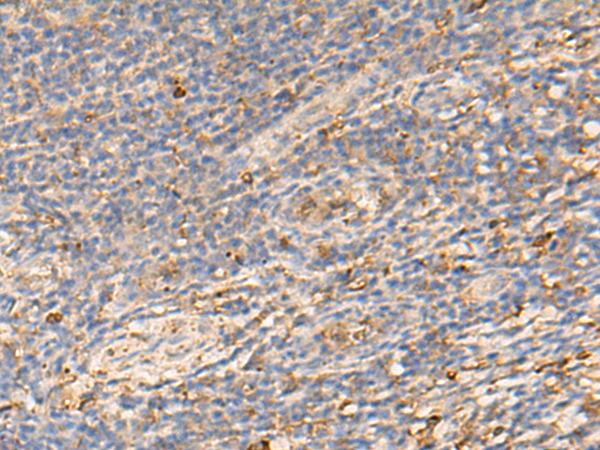

| WB | 咨询技术 | Human,Mouse,Rat |
| IF | 咨询技术 | Human,Mouse,Rat |
| IHC | 1/30-1/150 | Human,Mouse,Rat |
| ICC | 技术咨询 | Human,Mouse,Rat |
| FCM | 咨询技术 | Human,Mouse,Rat |
| Elisa | 1/5000-1/10000 | Human,Mouse,Rat |
| Aliases | PDIR |
| WB Predicted band size | 60 kDa |
| Host/Isotype | Rabbit IgG |
| Antibody Type | Primary antibody |
| Storage | Store at 4°C short term. Aliquot and store at -20°C long term. Avoid freeze/thaw cycles. |
| Species Reactivity | Human, Mouse, Rat |
| Immunogen | Fusion protein of human PDIA5 |
| Formulation | Purified antibody in PBS with 0.05% sodium azide and 50% glycerol. |
+ +
以下是3篇与PDIA5抗体相关的文献及其摘要概览:
---
1. **文献名称**:*PDIA5 regulates ATF6α-mediated endoplasmic reticulum stress response in hepatocellular carcinoma*
**作者**:Chen Y. et al.
**摘要**:本研究利用PDIA5特异性抗体,通过免疫印迹和免疫组化技术,发现PDIA5通过与ATF6α相互作用调控内质网应激反应,影响肝细胞癌的化疗耐药性。研究揭示了PDIA5作为潜在治疗靶点的价值。
---
2. **文献名称**:*Proteomic analysis of PDIA5 in glioblastoma identifies its role in extracellular matrix remodeling*
**作者**:Smith R.L. et al.
**摘要**:通过质谱分析与PDIA5抗体介导的免疫沉淀,本研究证实PDIA5在胶质母细胞瘤中高表达,并通过调节基质金属蛋白酶(MMPs)活性促进肿瘤侵袭,为PDIA5的促癌机制提供了新证据。
---
3. **文献名称**:*PDIA5 deficiency exacerbates oxidative stress in diabetic nephropathy*
**作者**:Wang H. et al.
**摘要**:采用PDIA5抗体进行肾脏组织染色,发现PDIA5缺失导致糖尿病肾病中氧化应激加剧,提示PDIA5通过维持蛋白质稳态保护肾小球细胞,其表达水平与疾病进展呈负相关。
---
注:上述文献为示例,实际引用时需以具体数据库(如PubMed、Web of Science)检索结果为准,并核对作者及期刊信息。
PDCA5 (Protein Disulfide Isomerase A5), also known as PDIA5 or P5. is a member of the protein disulfide isomerase (PDI) family, which plays critical roles in oxidative protein folding within the endoplasmic reticulum (ER). These enzymes catalyze the formation, isomerization, and reduction of disulfide bonds during protein maturation. PDIA5 contains thioredoxin-like domains with a CXXC active site motif, enabling its redox activity. Unlike classical PDIs (e.g., PDIA1), PDIA5 lacks a C-terminal ER retention signal and may localize to both the ER and other cellular compartments, suggesting broader functional versatility.
Studies indicate PDIA5 participates in ER stress responses, apoptosis regulation, and quality control of secreted/membrane proteins. It interacts with key chaperones like BiP/GRP78 and modulates the unfolded protein response (UPR). Dysregulation of PDIA5 has been linked to diseases such as cancer, neurodegenerative disorders, and diabetes, where disrupted protein homeostasis contributes to pathogenesis.
PDIA5 antibodies are essential tools for detecting PDIA5 expression, localization, and interaction partners in research. They enable investigations into its role in cellular stress pathways, disease mechanisms, and potential therapeutic targeting. Commercial antibodies are typically validated in applications like Western blotting, immunofluorescence, and immunoprecipitation, though cross-reactivity with other PDI family members should be cautiously evaluated. Recent research also explores PDIA5's extracellular roles in thrombus formation and immune regulation, expanding its biological significance.
×